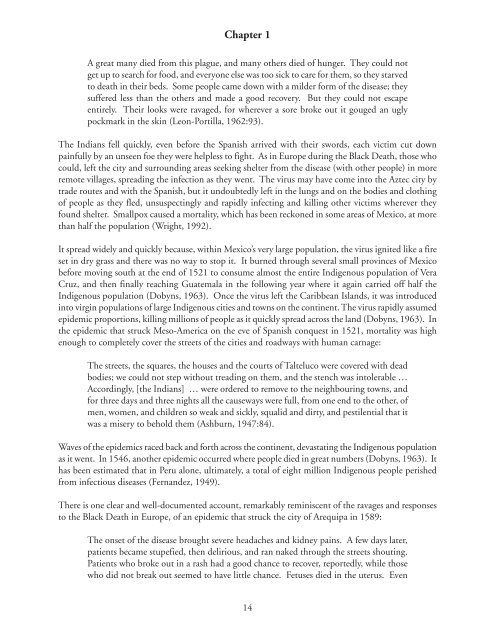Historic Trauma and Aboriginal Healing
by Cynthia C. Wesley-Esquimaux, Ph.D. and Magdalena Smolewski, Ph.D.
by Cynthia C. Wesley-Esquimaux, Ph.D. and Magdalena Smolewski, Ph.D.
Create successful ePaper yourself
Turn your PDF publications into a flip-book with our unique Google optimized e-Paper software.
Chapter 1<br />
A great many died from this plague, <strong>and</strong> many others died of hunger. They could not<br />
get up to search for food, <strong>and</strong> everyone else was too sick to care for them, so they starved<br />
to death in their beds. Some people came down with a milder form of the disease; they<br />
suffered less than the others <strong>and</strong> made a good recovery. But they could not escape<br />
entirely. Their looks were ravaged, for wherever a sore broke out it gouged an ugly<br />
pockmark in the skin (Leon-Portilla, 1962:93).<br />
The Indians fell quickly, even before the Spanish arrived with their swords, each victim cut down<br />
painfully by an unseen foe they were helpless to fight. As in Europe during the Black Death, those who<br />
could, left the city <strong>and</strong> surrounding areas seeking shelter from the disease (with other people) in more<br />
remote villages, spreading the infection as they went. The virus may have come into the Aztec city by<br />
trade routes <strong>and</strong> with the Spanish, but it undoubtedly left in the lungs <strong>and</strong> on the bodies <strong>and</strong> clothing<br />
of people as they fled, unsuspectingly <strong>and</strong> rapidly infecting <strong>and</strong> killing other victims wherever they<br />
found shelter. Smallpox caused a mortality, which has been reckoned in some areas of Mexico, at more<br />
than half the population (Wright, 1992).<br />
It spread widely <strong>and</strong> quickly because, within Mexico’s very large population, the virus ignited like a fire<br />
set in dry grass <strong>and</strong> there was no way to stop it. It burned through several small provinces of Mexico<br />
before moving south at the end of 1521 to consume almost the entire Indigenous population of Vera<br />
Cruz, <strong>and</strong> then finally reaching Guatemala in the following year where it again carried off half the<br />
Indigenous population (Dobyns, 1963). Once the virus left the Caribbean Isl<strong>and</strong>s, it was introduced<br />
into virgin populations of large Indigenous cities <strong>and</strong> towns on the continent. The virus rapidly assumed<br />
epidemic proportions, killing millions of people as it quickly spread across the l<strong>and</strong> (Dobyns, 1963). In<br />
the epidemic that struck Meso-America on the eve of Spanish conquest in 1521, mortality was high<br />
enough to completely cover the streets of the cities <strong>and</strong> roadways with human carnage:<br />
The streets, the squares, the houses <strong>and</strong> the courts of Talteluco were covered with dead<br />
bodies; we could not step without treading on them, <strong>and</strong> the stench was intolerable …<br />
Accordingly, [the Indians] … were ordered to remove to the neighbouring towns, <strong>and</strong><br />
for three days <strong>and</strong> three nights all the causeways were full, from one end to the other, of<br />
men, women, <strong>and</strong> children so weak <strong>and</strong> sickly, squalid <strong>and</strong> dirty, <strong>and</strong> pestilential that it<br />
was a misery to behold them (Ashburn, 1947:84).<br />
Waves of the epidemics raced back <strong>and</strong> forth across the continent, devastating the Indigenous population<br />
as it went. In 1546, another epidemic occurred where people died in great numbers (Dobyns, 1963). It<br />
has been estimated that in Peru alone, ultimately, a total of eight million Indigenous people perished<br />
from infectious diseases (Fern<strong>and</strong>ez, 1949).<br />
There is one clear <strong>and</strong> well-documented account, remarkably reminiscent of the ravages <strong>and</strong> responses<br />
to the Black Death in Europe, of an epidemic that struck the city of Arequipa in 1589:<br />
The onset of the disease brought severe headaches <strong>and</strong> kidney pains. A few days later,<br />
patients became stupefied, then delirious, <strong>and</strong> ran naked through the streets shouting.<br />
Patients who broke out in a rash had a good chance to recover, reportedly, while those<br />
who did not break out seemed to have little chance. Fetuses died in the uterus. Even<br />
14


















